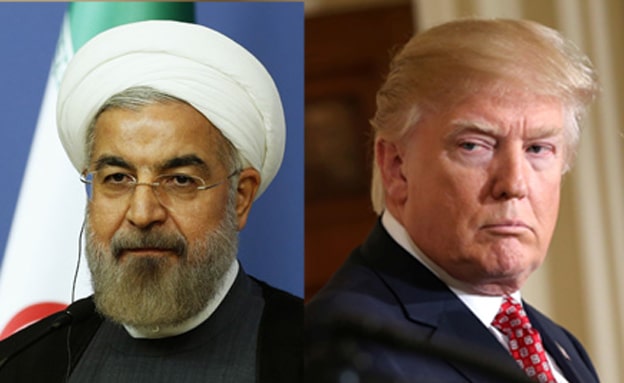
As I had written last week, a conversation of sorts has been under way between Washington and Tehran. The megaphone is no longer in use, the conversation is in civil tone from public platforms or more meaningfully, through the Twitter. It’s become an almost daily occurrence. Broadly speaking, the communication is between President Donald Trump from the American side, with Foreign Minister Javad Zarif actively interjecting on behalf of President Hassan Rouhani almost in real time. To be sure, the Supreme Leader Ali Khamenei is listening in.
The duet has incrementally come to be this: Trump is willing to meet with Rouhani “anytime… without preconditions.” He has a gut feeling lately that it could happen “very soon.” (When Trump puts a timeline like that in broad strokes, it hints at some back channel.) But then, Tehran says it will not talk under duress and injured pride and honor; US must first show “respect” and stop unfriendly activities.
On the other hand, Trump claims he perceives change in Iran’s behaviour. (It can be construed as a signal or an acknowledgment.) Interestingly, Tehran neither disputes Trump’s claim nor confirms it. In fact, there is some discernible “change” in Iran’s behavior – Moscow has disclosed that Iranian forces and the “Shi’ite formations” have withdrawn their heavy weapons in Syria to a distance of 85 km from the Israeli-occupied Golan Heights and “there are no units of heavy equipment and weapons that could pose a threat to Israel at a distance of 85 km from the line of demarcation.”
Clearly, this “change” in Iran’s behavior became possible in the backdrop of the Trump-Putin meet at Helsinki on July 16. The important thing is that Rouhani (read Khamenei) heeded Putin’s advice (at the behest of Trump.) Of course, Israeli PM Netanyahu, like Dickens’ Oliver Twist, keeps saying “Please, sir, I want some more” – namely, Iran should quit Syrian soil altogether, but that’s an “unrealistic” demand, as Moscow puts it. (Putin would have told that to Trump, too.) Which is to say, Moscow doesn’t have the inclination to advise Tehran to do otherwise. Nonetheless, this “change” of Iranian behavior in the Golan itself is a good thing as far as CBMs go.
Now, what about Tehran’s expectations? The first lot of Trump’s sanctions are supposed to “click in” next week. Will he hold back? Meanwhile, Zarif, US Secretary of State Mike Pompeo, Russian FM Sergey Lavrov, and Chinese FM Wang Yi as well as the EU foreign policy chief Federica Mogherini are converging on Singapore in the context of the ASEAN foreign ministers meeting through August 4.
En route to Singapore, Zarif tweeted: “Iran & U.S. had 2 yrs of talks. With EU/E3+Russia+China, we produced a unique multilateral accord—the JCPOA. It’s been working. US can only blame itself for pulling out & leaving the table. Threats, sanctions & PR stunts won’t work. Try respect: for Iranians & for int’l commitments.” This was in response to Trump’s remark that he is ready to meet with Rouhani without setting any pre-condition. “It’s good for the country, good for them, good for us and good for the world. No preconditions. If they want to meet, I’ll meet,” Trump had said.
Things have indeed narrowed down dramatically. Hamid Aboutalebi, an aide to President Rouhani, has clarified that rejoining the nuclear agreement is the major precondition for possible talks – “Respecting the Iranian nation’s rights, reducing hostilities and returning to the nuclear deal are steps that can be taken to pave the bumpy road of talks between Iran and America,” Aboutalebi tweeted.
But then, did Trump really tear up the 2015 deal? He said he wanted to improve upon the 2015 deal (which was not good enough in his judgment). Trump is determined to go down in history books as a smarter negotiator than Barack Obama — be it on climate change, TPP or Iran deal.
On the whole, these are positive stirrings. Significantly, sensing that “a meeting may not be beyond the realms of possibility,” Chinese government newspaper China Daily suggested in an editorial on July 31 that “the other parties to the (2015) nuclear agreement should encourage Washington and Teheran to get together as it really would be good to talk.”
Without doubt, China is a major stakeholder. Apart from being the destination for over a third of all Iranian oil exports, which inevitably makes it a target of collateral damage from US sanctions, China is also handling one of the trickiest templates of the 2015 deal – namely, the re-designing of the Arak heavy water nuclear reactor in Iran to render it unable to make bomb-grade plutonium under normal operation.
This subject had figured in the meeting between Rouhani and Chinese President Xi Jinping in Beijing in June on the sidelines of the SCO summit. On Arak, the 2015 deal specifies that the new design will aim to minimize the production of plutonium and to prevent the production of weapon-grade plutonium in normal operation. It also specifies the fuel Arak must use and says its spent fuel for the reactor’s lifetime must be shipped out of Iran. The US had initially led the working group to redesign the Arak reactor with China, but UK has now replaced it. Just think of all the mess Trump has created.
Reprinted with permission from India Punchline.

